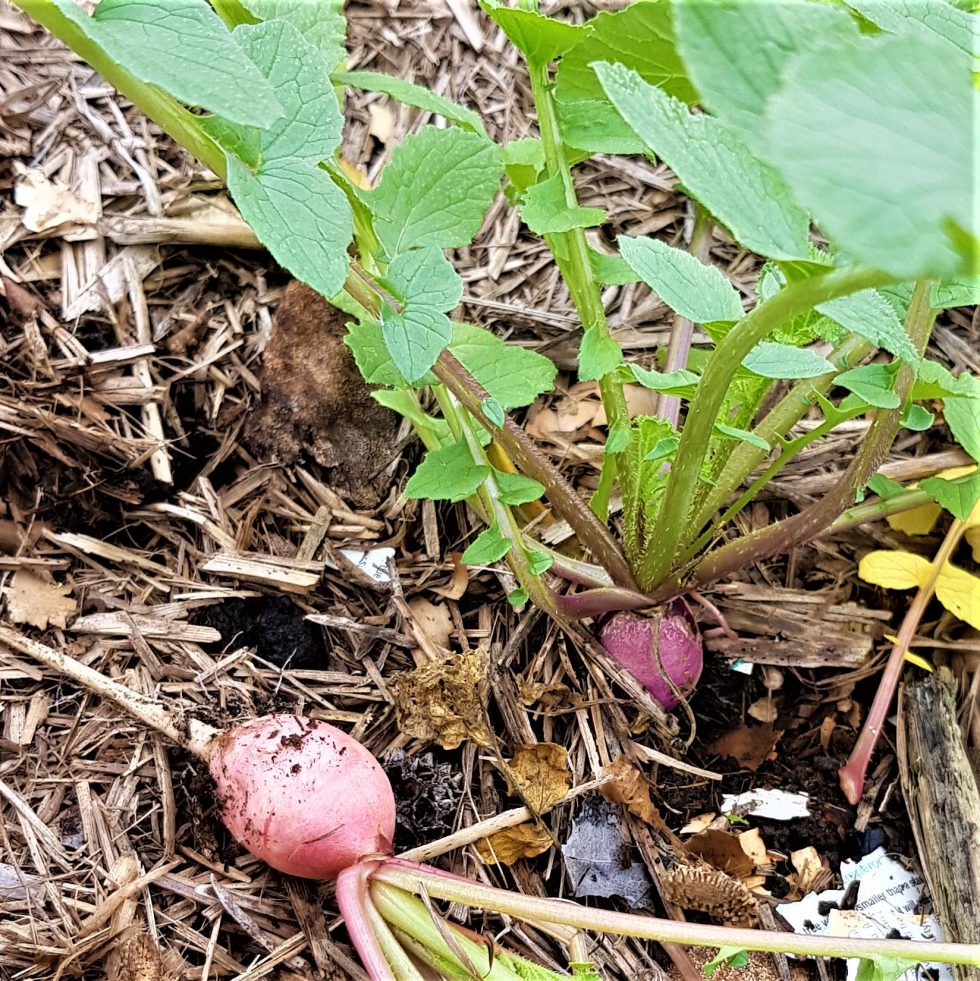RADISHES
Radishes grow just about anywhere. People think, ‘Oh it’s just a radish.’ But radishes are delicious, and people don’t think of cooking them.
Emeril Lagasse (American Celebrity Chef)
HISTORICAL INFORMATION
While there seems to be some dispute about the origin of radishes, some historians say that radishes originated in China and spread west to the Mediterranean area following the trade routes by land and sea. The Ancient Egyptians were known to have been cultivating radishes before the pyramids were built – around 5,000 years ago!1
Radishes arrived in Europe much later, they were known in Germany in the 13th century but were not written about in England until the mid-sixteenth century.1
DESCRIPTION
For most people, used to buying their radishes from supermarkets or greengrocers, radishes are either small, round and red (often watery or tasteless), or long and white! It may surprise you to learn that radishes come in different sizes, shapes, colours and intensity of heat! Radishes can be mild, like the small, red-skinned variety available commercially, but they can also be so pungent that, to be eaten raw, they must be sliced paper-thin!
Radish, Raphanus sativus, is a root vegetable, which pushes its way out the soil as it grows and can easily be seen when it is ready to harvest. The ease and speed with which radishes grow from seeds makes them popular with new gardeners, A small variety of radish can be ready in just 25 days in warm weather!2 In winter, they grow more slowly.
CULINARY and MEDICINAL USES
Radishes can be eaten fresh, cooked or pickled. The leaves of radishes are also edible, fresh in salads or cooked in the same way that other leafy greens are cooked.
Radishes are rich in antioxidants in the form of ascorbic acid.3 Being a root vegetable, radishes are high in carbohydrates, which give energy, and dietary fibre4; while also being of high nutrient value: particularly calcium, potassium and magnesium.3
The vegetable has been used to treat digestive complaints: indigestion, reflux and abdominal pain.5 They have also been used by herbalist to treat gall bladder conditions, such as gall-stones.4
Radish seeds have been used in traditional medicine for hundreds of years, as a treatment for disorders of the liver.3They were also used to treat phlegm-y coughs and asthma.5
OTHER BENEFITS
Radishes are good companion plants for a variety of vegetables6 (not hyssop or anise hyssop), and are believed to attract leaf miners from spinach.6
The flowers of radish plants attract pollinators and other beneficial insects to your garden and, after flowering, the seed pods are edible.7 (just be sure to save some seed).
HOW TO GROW RADISHES
Succession sow radish seeds directly where you want them to grow, every two or three weeks for a continual harvest throughout the growing season. Radishes grow best in Autumn or Spring; small radishes can be grown most of the year. Radishes can bolt in hot weather, so in summer provide them with afternoon shade by growing on the eastern side of the house or in the shade of taller plants grown on the western side of the radishes. Radishes grow best in lighter, sandy soils.8
Radishes are fast, easy to grow and, for most types, can be grown in containers.
RADISHES IN THE PSW SEEDBANK (your seedbank)
- Cherry Belle – popular, small, round, red variety – very few packets remaining
- China Rose – long, oblong-style to 20cm, strong flavour – plenty in stock
- Cincinnati Market – long, thin roots to 15cm, mild taste – limited stock
- French Breakfast – red root with white tip to 15cm, mild taste – plenty of stock
- German Giant – tennis ball sized roots, red skin, milder in cooler months – limited stock
- Japanese Daikon – long, white, tapered roots, mildly peppery – plenty in stock
- Long Black Spanish – pungent, peppery flavour; slice thinly – limited stock
- Purple Plum – purple skin, white flesh, sweet and mild – very limited stock
- Rat Tail – tall plant grown for the edible pods – plenty in stock
- Spanish Round Black (aka Nero Tonda) – round, black roots to 10cm – limited stock
- White Icicle – tapered, white roots to 15cm, mild – limited stock
- Weiner Runder – to tennis ball size, pungent, slice paper thin – plenty in stock
- Watermelon (aka Red Meat)– white skin, green shoulders, red interior, mild, sweet – plenty in stock
The Spring 2022 catalogue is now open for sales and closes on last Monday in November (28 Nov). For postage and handling, there will be an additional charge of $5. For “Click and Collect” at the next PSW or Seed Savers meeting, there is a $2 handling fee.
Please note: seeds are for the use of PSW members only. Please do not order if you are not a member, your order cannot be filled until your membership is paid. –
Thank you.
Until next month
Lynne (PSW Seed Savers Coordinator)
DISCLAIMER
This article is for gardening information and general interest only. Being neither a herbalist or qualified medical practitioner, I cannot give any medical advice on the use of radish, internally or externally. Readers of this article must do their own research before using radish for any purpose other than as a garden plant.
REFERENCES
- Wisconsin Department of Public Instruction, Radish
- Everwilde Farms Inc., Cherry Belle Radish Seeds
- Very Edible Gardens, Radish
- Acupuncture Today: Herbs and Botanicals, Radish (lai fu zi): What is radish? What is it used for?
- Australian School of Herbal Medicine, Radishes Provide the Health Kick Your Body Needs!
- Helen Tuton, Sustainable Gardening Australia, Companion Planting
- Bellwether Farming, 8 Reasons to Grow Radishes in Your Garden
- NSW Department of Primary Industries, Radish growing

